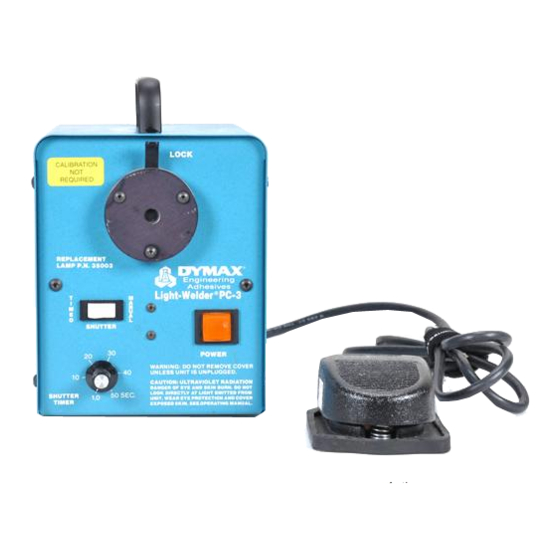dymax PC-3 운영 매뉴얼 - 페이지 4
{카테고리_이름} dymax PC-3에 대한 운영 매뉴얼을 온라인으로 검색하거나 PDF를 다운로드하세요. dymax PC-3 20 페이지. Ultra uv curing light source
dymax PC-3에 대해서도 마찬가지입니다: 운영 매뉴얼 (16 페이지)

SAFETY
Safety Precautions Must Be Observed By All Personnel
Working Near Or Around Ultraviolet (UV) Light
UV Terminology
The portion of the Electromagnetic spectrum which falls between x-rays and visible light
is called Ultraviolet or UV. Ultraviolet (UV) radiation can be classified into three
categories: UV-C, UV-B, and UV-A. UV-C is for the wavelengths below 280 nm, UV-B
is for the wavelengths between 280-315 nm, and UVA is for the wavelengths between
315-380 nm.
Exposure Hazards
Exposure to UV light, even for short periods of time, can be hazardous. The danger depends
upon the exposure time, the intensity of the light, the wavelength, and the individual's sensitivity
to UV. UV-B and UV-C can be considered the most hazardous to the skin, causing such effects
as sunburn. UV-A, UV-B, and UV-C is considered to be hazardous to the eyes, and is why eye
protection is important when working around UV light.
Ozone is a form of oxygen. Interaction of ultraviolet light below 220 nm with oxygen in the
surrounding air produces ozone, which is a powerful, toxic agent. It has a characteristic
pungent odor to which most people are quite sensitive (people can typically detect
concentrations of several parts per million). At high concentrations, it can cause discomfort, or
at sufficiently high levels, be dangerous. The PC-3 series of lamps produce minimal amounts of
ozone during start-up and no ozone during operation. The radiation beneath the wavelength of
about 240 nm, given off by the arc, is absorbed by the outer, colder gas layers and therefore,
produce no ozone during operation.
Safety Guidelines
The National Institute for Occupational Safety and Health (NIOSH) recommends that exposure
to UV energy be controlled and limited in the work place. Recommended maximum exposures
are available, but do not apply to photosensitive individuals.
The total intensity from 320 to 400 nm hitting unprotected skin or eyes should not exceed
1 mW/cm² for periods longer than 1000 seconds. For shorter exposure times, the total radiant
energy shall not exceed 1000 mWsec/cm².
TM-021 PN 35933
Rev 05/06/97
4
